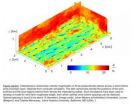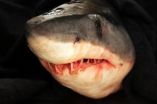(Press-News.org) WASHINGTON, D.C., November 23, 2010 -- For centuries, intellectuals have met at the ring-stained surfaces of coffee shops to pore over the most pressing problems of the day -- but has anyone ever pondered the coffee rings they left behind? What causes the formation of stain patterns left behind by coffee droplets on a surface?
You might think coffee ring formation, first described quantitatively by Deegan et al in a heavily cited article, is the most widely and ritualistically performed experiment in the world, given the prevalence of caffeine in cultures. But most of us lack the scanning electron microscope and mathematical models to evaluate our stain data properly, or reach meaningful conclusions beyond "Use a coaster."
Now Shreyas Mandre of Brown University, Ning Wu from Colorado School of Mines and L. Mahadevan and Joanna Aizenberg from Harvard University have devised a predictive model that combines laboratory studies of microscopic glass particles in solution with mathematical theories to predict the existence, thickness and length of the banded ring patterns that formed.
Their results, presented today at the American Physical Society Division of Fluid Dynamics meeting in Long Beach, CA, suggest the patterned deposition of particles can be controlled by altering physical parameters such as evaporation and surface tension -- and perhaps one day manipulated to create small-particle tools.
"Controlling the ring deposition process would be useful for creating such things as new microphysics tools operating at a scale where pliers or other traditional tools for moving particles cannot operate," notes Mandre.
The team found that during ring deposition, a particle layer of uniform thickness is deposited if the concentration is above a certain threshold. Below that threshold the deposits form non-uniform bands. The threshold is formed because evaporation at the solid-liquid interface of the rim occurs faster than a replenishing flow of water from the center of the droplet can replace the evaporating rim fluid. This leaves the particles on the rim high, dry -- and deposited.
Exploiting this competition between evaporation and replenishment is the key to controlling the process as a microtool, says Mandre. Potential applications include printing, making industrial coatings, fabricating electronics, and designing new medicines.
###The presentation, "Coffee ring deposition in bands" is at 4:23 p.m. on Tuesday, November 23, 2010 in the Hyatt Regency Long Beach Room: Regency A. ABSTRACT: http://meetings.aps.org/Meeting/DFD10/Event/134397
MORE MEETING INFORMATION
The 63rd Annual DFD Meeting is hosted this year by the University of Southern California, California State University Long Beach, California Institute of Technology, and the University of California, Los Angeles.
It will be held at the Long Beach Convention Center, located in downtown Long Beach, California. All meeting information, including directions to the Convention Center is at: http://www.dfd2010.caltech.edu/
USEFUL LINKS
Main meeting Web site:
http://www.dfd2010.caltech.edu/
Search Abstracts:
http://meetings.aps.org/Meeting/DFD10/SearchAbstract
Directions to Convention Center:
http://www.longbeachcc.com/
PRESS REGISTRATION
Credentialed full-time journalist and professional freelance journalists working on assignment for major publications or media outlets are invited to attend the conference free of charge. If you are a reporter and would like to attend, please contact Jason Bardi (jbardi@aip.org, 301-209-3091).
ONSITE WORKSPACE FOR REPORTERS
A reserved workspace with wireless internet connections will be available for use by reporters in the Promenade Ballroom of the Long Beach Convention Center on Sunday, Nov. 21 and Monday, Nov. 22 from 8:00 a.m. to 5:00 p.m. and on Tuesday, Nov. 23 from 8:00 a.m. to noon. Press announcements and other news will be available in the Virtual Press Room (see below).
VIRTUAL PRESS ROOM
The APS Division of Fluid Dynamics Virtual Press Room will be launched in mid-November and will contain dozens of story tips on some of the most interesting results at the meeting as well as stunning graphics and videos. The Virtual Press Room will serve as starting points for journalists who are interested in covering the meeting but cannot attend in person. See: http://www.aps.org/units/dfd/pressroom/index.cfm
GALLERY OF FLUID MOTION
Every year, the APS Division of Fluid Dynamics hosts posters and videos that show stunning images and graphics from either computational or experimental studies of flow phenomena. The outstanding entries, selected by a panel of referees for artistic content, originality and ability to convey information, will be honored during the meeting, placed on display at the Annual APS Meeting in March of 2011, and will appear in the annual Gallery of Fluid Motion article in the September 2011 issue of the American Institute of Physics' journal, Physics of Fluids.
This year, selected entries from the 28th Annual Gallery of Fluid Motion will be hosted as part of the Fluid Dynamics Virtual Press Room. In mid-November, when the Virtual Press Room is launched, another announcement will be sent out.
ABOUT THE APS DIVISION OF FLUID DYNAMICS
The Division of Fluid Dynamics of the American Physical Society (APS) exists for the advancement and diffusion of knowledge of the physics of fluids with special emphasis on the dynamical theories of the liquid, plastic and gaseous states of matter under all conditions of temperature and pressure. See: http://www.aps.org/units/dfd/
END
WASHINGTON, D.C., November 23, 2010 -- Wind farms around the world are large and getting larger. Arranging thousands of wind turbines across many miles of land requires new tools that can balance cost and efficiency to provide the most energy for the buck.
Charles Meneveau, who studies fluid dynamics at Johns Hopkins University, and his collaborator Johan Meyers from Leuven University in Belgium, have developed a model to calculate the optimal spacing of turbines for the very large wind farms of the future. They will present their work today at the American Physical ...
WASHINGTON, D.C., November 23, 2010 -- To the causal aquarium visitor, the jellyfish doesn't seem to be a particularly powerful swimmer; compared to a fish, it glides slowly and peacefully.
But for Janna Nawroth, a graduate student at the California Institute of Technology in Pasadena, the undulations of this simple invertebrate hold secrets that may make possible a new generation of tiny pumps for medical applications and soft robotics -- work she describes today at the American Physical Society Division of Fluid Dynamics (DFD) meeting in Long Beach, CA
"Most pumps ...
WASHINGTON, D.C., November 23, 2010 -- Magnetic fluid hyperthermia (MFH) is a promising new cancer treatment that essentially "fries" cells inside tumors. The procedure has been used successfully in prostate, liver, and breast tumors. Magnetic nanoparticles (each billionths of a meter in size) are injected into the body intravenously and diffuse selectively into cancerous tissues. Add a high-frequency magnetic field, and the particles heat up, raising the temperature of the tumor cells.
"The entire tumor volume is heated above a threshold treatment temperature -- typically ...
WASHINGTON, D.C., November 23, 2010 -- New research from the University of South Florida suggests that one of the evolutionary secrets of the shark's success hides in one of its tiniest traits -- flexible scales on the bodies of these peerless predators that make them better hunters by allowing them to change directions while moving at full speed.
The key to this ability lies in the fact that the scales control water flow separation across the creatures' bodies, says Amy Lang of the University of Alabama who will present work she performed with her colleagues at the University ...
Pity the poor female fruit fly. Being a looker is simply not enough, it seems. If you're to get a date, much less a proposal, you must also smell and act like a girl. Otherwise, you might just have a fight on your hands. Read more in next week's issue of the online, open access journal PLoS Biology.
As with most animals, Drosophila face the problem of distinguishing between a potential mate and a potential competitor. If, when meeting a second fruit fly, a male fly thinks "female," he'll begin courting her. But if he senses another male, he'll fight. What triggers these ...
###
El Consejo Civil Mexicano para la Silvicultura Sostenible, A.C. (the Mexican Civil Council for Sustainable Forestry, known as CCMSS) is a non-profit, non-governmental organization that encourages and promotes conservation of forest ecosystems that are managed by the forest communities themselves. Known as Manejo Forestal Comunitario, or MFC, this system is supported by CCMSS members, who work in collaboration with communities and ejidos to put in place sustainable practices in forest management and improve the development, conservation, industrialization and commercialization ...
Performing a combination of aerobic exercise and resistance training was associated with improved glycemic levels among patients with type 2 diabetes, compared to patients who did not exercise, according to a study in the November 24 issue of JAMA. The level of improvement was not seen among patients who performed either aerobic exercise or resistance training alone.
Although it is generally accepted that regular exercise provides substantial health benefits for individuals with type 2 diabetes, the exact exercise type (aerobic vs. resistance vs. both) has been unclear. ...
A comparison of two strategies to determine the stage of suspected non-small cell lung cancer (NSCLC) finds that the less invasive method is more effective at identifying a type of lung cancer that has spread, and may result in a reduction of unnecessary surgical procedures and associated adverse effects for certain patients, according to a study in the November 24 issue of JAMA.
Lung cancer is the most commonly diagnosed cancer worldwide (1.35 million/year) and also the most frequent cause of cancer death (1.2 million/year). Determining the stage of cancer is an important ...
Annual screening by fecal immunochemical testing—a test that detects blood in the stool, has high sensitivity and specificity, and might improve participation rates through increased patient acceptability—reduces the risk of colorectal cancer and colorectal cancer related deaths, and reduces healthcare costs in comparison to all other screening strategies and to no screening. These are the conclusions of a complete economic evaluation performed by Braden Manns and colleagues from the University of Calgary, Alberta, Canada, and published in this week's PLoS Medicine.
Clinical ...
China had an estimated 1.3 million new cases of tuberculosis (TB) in 2008, of which 112,000 were multi-drug resistant (MDR-TB). Over the period 2001, TB was the second largest cause of death among China's 39 notifiable communicable diseases. In a Policy Forum, published in this week's PLoS Medicine, Zhong-wei Jia (Peking University) and colleagues from Beijing, China, report on how a combination of increased domestic funding, supplemented by foreign loans and donations, led to a dramatic increase in TB case finding. The authors also highlight the way in which changes in ...

